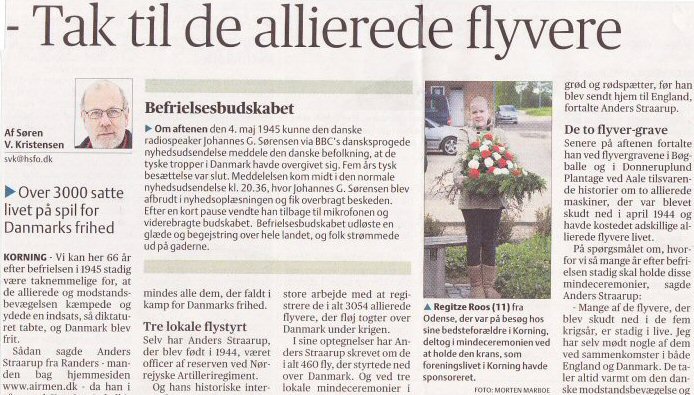  The top of the text of
The top of the text of
Thanks to the Allied airmen
in
Horsens Folkeblad on 5 May 2011.
See also the photo.
By Søren V. Kristensen
svk@hsfo.dk
Befrielsesbudskabet -
The message of liberation
"On 4 May 1945 in the evening the Danish announcer Johannes G. Sørensen in
the broadcast in Danish from the BBC could
inform the people
of Denmark that the
German troops in
Denmark had surrendered. Five years of occupation by the Germans
were over.
The message came in the middle
of the
normal radio news at 20.36.
Johannes G. Sørensen was interrupted
in reading the news and he was given the
message. After a short break he returned
to the microphone and passed it on. The message of liberation triggered joy
and excitement all over the country and people
took to the streets."
"Regitze Roos, 11, from Odense was visiting her Grandparents in
Korning. She participated in the memorial ceremony by holding the wreath
presented by
associations
in Korning. Photo: Morten Marboe"
KORNING - 66 years after the liberation in
1945 we can still be grateful that the Allied and the Danish Resistance
movement fought and made an effort so that the dictatorship lost and Denmark
became a free country.
That is what Anders Straarup from Randers - the man behind the website
www.airmen.dk - said, when he
laid a wreath at the memorial stone at Korning
School yesterday to commemorate all who fell in the fight for the freedeom of Denmark.
Three local air crashes
Anders Straarup, born in 1944, has been an officer of the reserve of the
Artillery Regiment of Northern Jutland. And his interest in the history of
World War II 1939-45 including the occupation of Denmark by the German
Wehrmacht has made him do the comprehensive job of registering the 3,054
Allied airmen who flew missions
over Denmark during the war. (Comment: I
write about 3,054 airmen from 460 planes - most of the shot down over
Denmark. See Airmen 1946.
Helge W. Gram
calculated
that Allied planes flew over Denmark
about 40,000 times on their way to or from
bombing raids on Germany or minelaying operations. Only a very small
part
of the
flights involved supplies of weapons for the Danish resistance. AS.)
In his records Anders Straarup has written about the 460 planes that crashed
in Denmark, and at three local memorial ceremonies last night in
Korning, Bøgballe
and
Aale he told about three crashes in this area.
Porridge and plaices
On 12 September 1941 at a time when the Germans were still moving forward
and the Americans were still neutral, a British bomber crashed into a field
near Stouby Church when an engine had been damaged. The crew of four bailed
out and saved their lives. Danish police deployed many men in a search for
the airmen and three
of them were soon captured.
But the last - James Alexander Philson - had
disappeared. Four days later he was found in the brake compartment of a
goods van which was standing at Daugaard
railway station. The railwayman
called the police, and that was the end of the escape. However, later the
prisoner was invited to a dinner at Daugaard Inn. He got the
seat of honour at the table. He had rice pudding and plaice before he was
sent back to England, Anders Straarup related. (Comment: He was found by a
railwayman
and then turned over to
Danish
Police. A German Major agreed to let Danish police
interrogate him (see Palle Høybye 1980) and
then he would be back at 14.00
hours
to fetch Philson. On 7 June 2012 Philson added, "The Germans were completely
unawere of what was going on. They had been told that the Police were
interrogating me! When they did return it was with typical Teutonic arrogance & bluster."
(See Photo of Philson at Daugaard Inn.) Then
Philson was taken to
German POW-Camps, not to England! I mentioned the remarkable
speeches in Daugaard in my speech in Korning.
AS)
The two graves of airmen
Later in the evening he told similar stories at the graves of airmen in
Bøgballe and in Donneruplund near Aale about two Allied planes that had been
shot down at the
cost of the lives of a number of Allied airmen. (Comment: The burials took
place in Esbjerg, but there are memorial stones at the crash sites near
Bøgballe and Aale.)
To the question why we should still hold these
memorial ceremonies after the war, Anders Straarup said,
"Many of the airmen who were shot down during the 5 years of war are still alive. I have met some of them at reunions in both England and Denmark. They
always
speak warmly of the Danish Resistance Movement and the common effort
which meant that the Germans were defeated.
Yes, 4 May is still worth a celebration. And for me it is shocking to read
that today many Danish pupils in Primary and in Secondary Schools do not
know what
happened on 9 April 1940, when Denmark was occupied, and on 4 May 1945, when
we were liberated, Anders Straarup added. (Comment: I also mentioned the
Mosquito Aircrew Reunion and talks with
Lester Schrenk on Skype. AS)
At the end of the day the Army Home Guard
Company Hedensted and the Denmark Society offered a cup of coffee at the
Home Guard Centre in Honum." |
